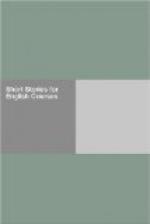It must not be supposed from the foregoing explanation that the three essentials of the short story are ever really divorced. They are happily blended in many of our finest stories. Nevertheless, analysis of any one of these will show that in the mind of the writer one purpose was pre-eminent. On this point Robert Louis Stevenson thus speaks: “There are, so far as I know, three ways and three only of writing a story. You may take a plot and fit characters to it, or you may take a character and choose incidents and situations to develop it, or, lastly, you may take a certain atmosphere and get actions and persons to express and realize it.” When to this clear conception of his limitations and privileges the author adds an imagination that clearly visualizes events and the “verbal magic” by which good style is secured, he produces the short story that is a masterpiece.
HOW THIS BOOK MAY BE USED
This book may be used in four ways. First, it may serve as an appetizer. Even the casual reading of good literature has a tendency to create a demand for more. Second, it may be made the basis for discussion and comparison. By using these stories, the works of recognized authors, as standards, the student may determine the value of such stories as come into his home. Third, these selections may be studied in a regular short-story course, such as many high schools have, to illustrate the requirements and the types of this form of narration. The chapter on “The Requirements of the Short Story” will be found useful both in this connection and in the comparative study of stories. Fourth, the student will better appreciate and understand the short story if he attempts to tell or to write one. This does not mean that we intend to train him for the literary market. Our object is entirely different. No form of literature brings more real joy to the child than the story. Not only does he like to hear stories; he likes to tell them. And where the short-story course is rightly used, he likes to write them. He finds that the pleasure of exercising creative power more than offsets the drudgery inevitable in composition. A plan that has been satisfactorily carried out in the classroom is here briefly outlined.
The teacher reads with the class a story in which plot furnishes the main interest. This type is chosen because it is more easily analyzed by beginners. The class discusses this, applying the tests of the short story given elsewhere in this book. Then a number of short stories of different types are read and compared. Next, each member of the class selects from some recent book or magazine a short story he enjoys. This he outlines and reports to the class. If this report is not satisfactory, the class insists that either the author or the reporter be exonerated. The story is accordingly read to the class, or is read and reported on by another member. The class is then usually able to decide whether the story is faulty or the first report inadequate.




